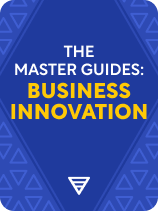

This article is an excerpt from the Shortform book guide to "The Master Guides: Business Innovation" by Shortform. Shortform has the world's best summaries and analyses of books you should be reading.
Like this article? Sign up for a free trial here.
What happens to businesses that lack innovation? How can you come up with ingenious ideas that will make customers swoon?
A lack of innovation is a serious problem in many companies. Without it, they fail to come up with new ideas that excite customers and fall behind in the market.
Keep reading for some suggestions to help you embrace innovation and start thinking differently about your product.
Boosting Innovation
Some experts argue that the high failure rate of innovation projects is, in essence, largely an illusion, since most of these projects have a lack of innovation. Recall that to be truly innovative a new product must be both different and better. Not all product developments fit these parameters: A company might produce something that isn’t clearly differentiated from existing alternatives, or a product with differences that don’t offer meaningful advantages to customers. It stands to reason that these new products wouldn’t succeed in the market.
We’ll examine how different authors address the problem of insufficient innovation, focusing mostly on evaluating whether potential ventures are innovative enough to succeed and the different types of innovation to consider.
The Ten Types of Innovation
In Ten Types of Innovation, Larry Keeley, cofounder of the Doblin Innovation Firm, and his Doblin colleagues Ryan Pikkel, Brian Quinn, and Helen Walters assert that all innovations can be classified into 10 standard categories. They observe that most successful disruptive innovations (that is, most of the new products and services that reshape markets and generate substantial growth for the company) incorporate innovations in at least five of the 10 categories.
The key to success, then, is to understand what types of innovation your new offering incorporates and, if necessary, innovate in additional categories. The 10 categories that Keeley et al. identify are:
- Core product innovations: These innovations focus on improving your product or service enough to make it stand out as unique. That could mean adding features that increase its capabilities, removing features to make it simpler and more user-friendly, tailoring it to better meet a certain user’s needs, or just producing it to a higher standard of quality.
- Interfacing product innovations: With these innovations, you enhance the value or profitability of your product by improving how it interacts with other products. This might mean bundling your product with complementary products, enabling users to customize your product with third-party accessories, or giving users tools to create their own add-ons.
- Capability innovations: These innovations improve how you produce your product or provide your service, allowing you to make it better or more efficiently. Maybe you invest in greater automation to increase efficiency, make use of patented production processes, or crowdsource part of your service by giving users tools to help each other.
- Organizational innovations: With this type of innovation, you consider novel corporate structures or unique arrangements of personnel and assets that might give you an advantage. Maybe an exceptionally flat corporate hierarchy empowers your company by facilitating the free flow of information between upper management and line-level employees. Or maybe decentralizing production assets lets you adapt more rapidly to changing market conditions.
- Relational innovations: With this type of innovation, you find novel ways to collaborate with other organizations so that they bring additional value to your product—in other words, you find ways to leverage your relationships with other companies. For example, maybe you turn your service into a franchise, and you train local companies to service customers instead of you servicing them directly.
- Revenue stream innovations: These innovations encompass anything unique and beneficial about how a company makes money. For example, maybe you find a way to offer your product for free so that you make money through advertising or support contracts instead of sales, leading to wider adoption. Or maybe you attract a different class of customers by offering either a premium version of the product or a more affordable version.
- Distribution innovations: This type of innovation focuses on ease of purchasing—making it easy to distribute your product to your customer, either by making it easier for your customers to purchase or making the purchasing process stand out in a good way.
- Support innovations: These innovations support your customers in their use of your product in exceptional ways. For example, you could guarantee zero downtime and offer to reimburse business customers for any revenue they lose if your product does go down.
- Branding innovations: Through branding innovation, products become more valuable because your brand identity stands behind them. Your customers are willing to pay more for your products because they trust you to stand behind your products more than they trust other companies, because the way your company does business resonates with their values, or because your brand conveys social status in a way that others don’t.
- Gratification innovations: This type of innovation revolves around understanding your customers’ values and aspirations and designing your product so they get more gratification from using it. For example, you might let users customize the appearance of your product when they buy it so it becomes a form of self-expression for them.
Blue Ocean Strategy
As we’ve discussed, Keeley et al. argue that innovating in enough categories is crucial for the success of disruptive innovation projects. Similarly, in Blue Ocean Strategy, W. Chan Kim and Renée Mauborgne also advise you to innovate in multiple areas, arguing that your ultimate goal should be to create not just a new product but a new and uncontested market that your product will dominate. This offers the best route to success, because if you try to merely compete with established companies in existing markets, you’ll end up with low profit margins and minimal opportunities for growth.
To spark ideas for innovative products, Kim and Mauborgne recommend considering your product from several angles:
- Consider all the different products that your customers could use to achieve the same goal through different means. For example, rock-climbing gear and video games are different in form and function, but they fulfill the same basic goal of connecting with friends in a thrilling environment. Ask yourself if you could combine desirable features from different alternatives to provide unique value.
- Consider what characteristics motivate your customers to buy higher-quality products at higher prices versus lower quality at lower prices. Ask yourself if you can create a unique offering by focusing on the characteristics they’re willing to pay extra for and eliminating the others.
- Identify underserved people in the purchasing chain. If the end user and the person with purchasing power are not one and the same, the end user may have pain points, or persistent problems, you can address to provide unique value.
- Consider what happens before, during, and after your product is used. Kim and Mauborgne note that products are rarely used in isolation. Ask yourself whether there’s friction between any of these handoffs that you could alleviate to create unique value. It might be as simple as bundling complementary products with yours.
- Kim and Mauborgne observe that most industries tend to gravitate toward either functionality or emotion. Consider making an emotional industry more functional by stripping away unnecessary extras, or making a functional industry more emotional.
- Consider the needs of non-customers. Ask yourself why some people don’t buy your current product or products in your industry. Can you develop a new offering to solve the problem that’s keeping them away?
Then, to help you visualize whether a new product idea provides unique value, Kim and Mauborgne introduce the blue ocean strategy chart. On the horizontal axis, you list the attributes of your product that your customers care about. The vertical axis represents how much each attribute is present in a product. You plot the value of each characteristic on the graph as a point, and connect the points to create a strategy curve, both for your product (or prospective new offering) and its leading alternatives. The result might look something like this:

Kim and Mauborgne point out that if your product’s path closely follows another product (like Product X and Product Y in our example graph) then you’re not providing unique value. You want your strategy curve to diverge significantly from every other company’s.
While they both offer unique insights, there are many similarities between Blue Ocean Strategy and the innovation strategy presented in the Ten Types of Innovation. Both emphasize breadth of innovation across a variety of factors as the key to creating an adequately differentiated (or sufficiently innovative) product. There is also considerable overlap in the factors that they consider. For example, Kim and Mauborgne’s advice to identify complementary products mirrors Keeley et al.’s advice to consider interfacing product innovations.
Zero to One
In Zero to One, Peter Thiel echoes Kim and Mauborgne’s assertion that innovation is the key to avoiding direct competition, which is the key to growth and profit. He argues that first-of-a-kind products create de facto monopolies, which are not only good for your company, but also have the potential to benefit society. Thiel says you need five things to successfully launch a disruptive innovation startup:
- Revolutionary technology or opportunity: Making an incremental improvement to an existing technology is generally not a great opportunity. You need a breakthrough that provides fundamentally new capabilities, or, at the very least, increases existing capabilities by a factor of 10. You also need to be the only one pursuing it. Otherwise, competition will consume all your profits.
- Strategic timing: Even if you’re the first to invent a revolutionary technology, there needs to be widespread interest in solving a problem that the technology can solve for it to be a commercial success.
- A great team: For an innovative business venture to succeed, you need managers and employees who are motivated and unified by the venture’s unique mission. Thiel advises that you choose people whose technical and interpersonal skills complement each other, establish clearly defined roles and responsibilities, and don’t overpay your CEO.
- Effective distribution: Planning how to market and distribute your product is an integral part of designing it. For your venture to be viable, the cost of acquiring a customer (through advertising or other means) must be less than the total profits you’ll make from that customer—ideally no more than 30% of it.
- Enduring value: You need to be the first to introduce your product in order to build a monopoly that will generate long-term profits, but moving first is just a means to an end, not an end in itself. Your product must be something that people will still want to buy in years to come and that’s difficult for other companies to copy.
The idea that innovation projects must be truly innovative to succeed features prominently in Thiel’s criteria for a successful venture, since he stipulates that your product must use revolutionary technology and provide enduring value. But by stipulating that you also need a great team and effective distribution, he also highlights the importance of sound business practices for innovation projects. This is something that most authors at least touch on, and some see business management errors as the primary reason innovation projects fail, as we’ll discuss more fully in the next section.
That said, other authors, such as Keeley, identify even these areas of business management as opportunities for innovation: For example, a unique distribution method that makes your product easier to buy and a unique team structure that gives your company a competitive edge meet Keeley’s definitions of distribution innovation and organizational innovation, respectively.

———End of Preview———
Like what you just read? Read the rest of the world's best book summary and analysis of Shortform's "The Master Guides: Business Innovation" at Shortform.
Here's what you'll find in our full The Master Guides: Business Innovation summary:
- The reason why most innovations never lead to growth or profits
- Key principles for implementing innovative ideas that deliver value
- Advice from seven leading experts on overcoming innovation challenges






